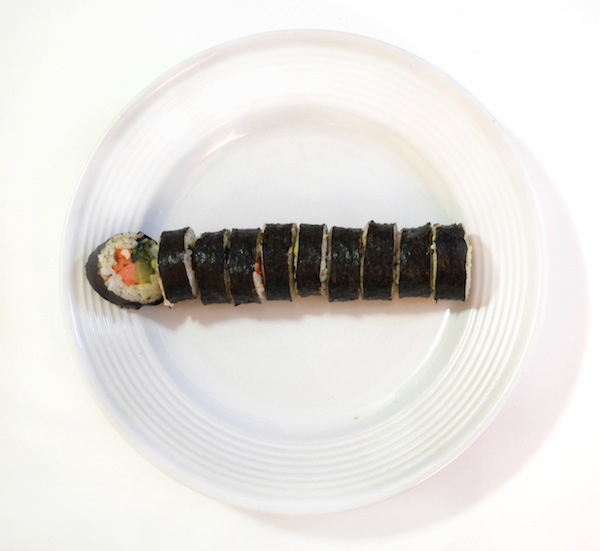Summer is the time for picnics, and my favorite Korean dish to eat outdoors is kimbap (김밮) or "seaweed rice." As you can see above, it is similar to a sushi roll. The dish originated during the Japanese occupation of Korea. It has evolved from sushi, however, and is now a distinct Korean dish that is sold everywhere in Korea at food stands.
There are many variations featuring fish cakes, imitation crab meat, eggs, beef, or even spam. I like kimbap with just vegetables, but it also tastes great with tempeh or ground seitan if you want to add more fillings. Pickled yellow radish is essential to kimbap, and you should be able to find it at most Asian grocery stores. You will also need a bamboo rolling mat to make the rolls. While it's tricky at first to roll the kimbap, it gets easier, and I find it fun to do.
serves 3-4
1/8 yellow picked radish
2 carrots
1/2 bunch of spinach
1 teaspoon plus 1 teaspoon of vegetable oil
3 cups cooked white rice, cooled slightly
1 teaspoon of rice vinegar
2 teaspoons of sesame oil
1 1/2 tablespoons of crushed toasted sesame seeds
6 sheets of toasted laver seaweed
A bowl of cold water
Cut the radish and carrots into long strips about 1/4 inch thick.
Heat 1 teaspoon of the vegetable oil in a frying pan over medium heat, and saute the carrots until slightly tender, about 5-6 minutes. Set aside.
Heat the remaining vegetable oil in the same frying pan over medium heat, and saute the spinach until wilted, about 2-3 minutes. Set aside.
In a medium-sized bowl, toss the rice, rice vinegar, sesame oil, and sesame seeds together.
Set out the vegetables, rice, and the water on your preparation surface.
Place a sheet of seaweed, shiny side down, on a bamboo roller. Spoon a 1/2 cup of the rice on the sheet and spread and press it down until it covers about 1/2 of the sheet towards you. Add 1-2 pieces of the radish and carrots and some of the spinach in the middle of the rice. Try to keep the fillings proportional. Wrap the roll away from you, and squeeze the roll tightly with your fingers and pull the bamboo roller by the edge away from you as you go. To help keep the kimbap's shape, cover the finished roll with part of the bamboo roller and squeeze a few more times. Repeat this part until you have used all the rice and fillings.
Use a large chef's knife dipped into the water to cut the rolls into slices about 1/4-1/2 inch thick.

No comments:
Post a Comment